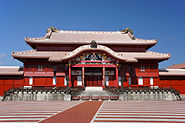History[edit]
| History of Ryukyu |
|---|
 |
Early Okinawan history is defined by midden or shell heap culture, and is divided into Early, Middle, and Late Shell Mound periods. The Early Shell Mound period was a hunter-gatherer society, with wave-like opening Jōmon pottery. In the latter part of this period, archaeological sites moved near the seashore, suggesting the engagement of people in fishing. In Okinawa, rice was not cultivated until the Middle Shell Mound period. Shell rings for arms made of shells obtained in the Sakishima Islands, namely Miyakojima and Yaeyama islands, were imported by Japan. In these islands, the presence of shell axes, 2500 years ago, suggests the influence of a southeastern-Pacific culture.[citation needed][6][7]
After the Late Shell Mound period, agriculture started about the 12th century, with the center moving from the seashore to higher places. This period is called the Gusuku period. Gusuku is the term used for the distinctive Ryukyuan form of castles or fortresses. Many gusukus and related cultural remains in the Ryukyu Islands have been listed by UNESCO as World Heritage Sites under the title Gusuku Sites and Related Properties of the Kingdom of Ryukyu. There are three perspectives regarding the nature of gusukus: 1) a holy place, 2) dwellings encircled by stones, 3) a castle of a leader of people. In this period, porcelain trade between Okinawa and other countries became busy, and Okinawa became an important relay point in eastern-Asian trade. Ryukyuan kings, such as Shunten and Eiso, were important rulers. An attempted Mongolian invasion in 1291 during the Eiso Dynasty ended in failure. Hiragana was imported from Japan by Ganjin in 1265. Noro, village priestesses of the Ryukyuan religion, appeared.
The Sanzan period began in 1314, when the kingdoms of Hokuzan and Nanzan declared independence from Chūzan. The three kingdoms competed with one another for recognition and trade with Ming China. King Satto, leading Chūzan, was very successful, establishing relations with Korea and Southeast Asia as well as China. The Hongwu Emperor sent 36 families from Fujian in 1392 at the request of the Ryukyuan King. Their job was to manage maritime dealings in the kingdom. Many Ryukyuan officials were descended from these Chinese immigrants, being born in China or having Chinese ancestors. They assisted the Ryukyuans in developing their technology and diplomatic relations. In 1407, however, a man named Hashi overthrew Satto's descendant, King Bunei, and installed his own father, Shishō, as king of Chūzan. After his father died, Hashi became king, and the Xuande Emperor of China gave him the surname "Shō" (Chinese: Shang).
In 1429, King Shō Hashi completed the unification of the three kingdoms and founded the Ryūkyū Kingdom with its capital at Shuri Castle. His descendants would conquer the Amami Islands. In 1469, King Shō Taikyū died, so the royal government chose a man named Kanemaru as the new king, who chose the name Shō En and established the Second Shō Dynasty. His son, Shō Shin would then conquer the Sakishima Islands and centralize the royal government, the military, and the noro priestesses.
In 1609, the Japanese domain of Satsuma launched an invasion of the Ryukyu Kingdom, ultimately capturing the king and his capital after a long struggle. Ryukyu was forced to cede the Amami Islands and become a vassal of Satsuma. The kingdom became both a tributary of China and a tributary of Japan. Because China would not make a formal trade agreement unless a country was a tributary state, the kingdom was a convenient loophole for Japanese trade with China. When Japan officially closed off trade with European nations except the Dutch, Nagasaki, Tsushima, and Kagoshima became the only Japanese trading ports offering connections with the outside world.
A number of Europeans visited Ryukyu starting in the late 18th century. The most important visits to Okinawa were from Captain Basil Chamberlain in 1816 and Commodore Matthew C. Perry in 1852. A Christian missionary, Bernard Jean Bettelheim, lived in the Gokoku-ji temple in Naha from 1846 to 1854.
In 1879, Japan annexed the entire Ryukyu archipelago.[8] The Meiji government then established Okinawa Prefecture. The monarchy in Shuri was abolished and the deposed king Shō Tai (1843–1901) was forced to relocate to Tokyo.
Hostility against Japan increased in the islands immediately after the annexation in part because of the systematic attempt on the part of Japan to eliminate Ryukyuan culture, including the language, religion, and cultural practices.
The island of Okinawa was the site of most of the ground warfare in the Battle of Okinawa during World War II, when United States Army and Marine Corps troops fought a long and bloody battle to capture Okinawa, so it could next be used as the major air force and troop base for the planned invasion of Japan. During this 82-day-long battle, about 95,000 Imperial Japanese Army troops and 12,510 Americans were killed. The Cornerstone of Peace at the Okinawa Prefecture Memorial Peace Park lists 149,193 persons of Okinawan origin – approximately one quarter of the civilian population – who either were killed or committed suicide during the Battle of Okinawa and the Pacific War.[9]
During the American military occupation of Japan (1945–52), which followed the Imperial Japanese surrender on September 2, 1945, in Tokyo Bay, the United States controlled Okinawa Island and the rest of the Ryukyu Islands. The Amami Islands were returned to Japanese control in 1953, but the rest remained in American possession until June 17, 1972, with numerous Army, Marine Corps, and Air Force bases there.
Demographics[edit]
As of September, 2009, the Japanese government estimates the population at 1,384,762,[10] which includes American military personnel and their families. The Okinawan language, called Uchinaaguchi, is spoken mostly by the elderly.[11]But several local groups promote the use of the Okinawan language by younger people.[12]
Whereas the northern half of Okinawa Island is sparsely populated, the south-central and southern parts of the island are markedly urbanized—particularly the city of Naha and the urban corridor stretching north from there to Okinawa City.




No comments:
Post a Comment